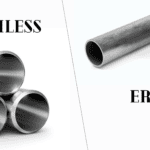Introduction
In the world of metal alloys, two commonly used materials are stainless steel and mild steel. While they may share some similarities, they also have distinct differences in terms of composition, characteristics, and applications. In this article, we will delve into the details of Mild Steel vs Stainless Steel, highlighting their unique properties and helping you understand which material is best suited for various purposes.
Mild Steel
MS Steel Full Form
Mild steel, also known as carbon steel or plain carbon steel, is an alloy primarily composed of iron and carbon. It lacks the chromium content that provides stainless steel with its corrosion resistance properties.
Mild Steel Composition
Mild steel typically contains a low carbon content, usually less than 0.3%, and traces of other elements such as manganese, silicon, and phosphorus. The absence of significant alloying elements makes mild steel less expensive and more readily available compared to stainless steel.
Mild Steel Properties
Mild steel possesses distinct properties that make it suitable for a wide range of applications:
- Affordability: Mild steel is more cost effective than stainless steel, making it a popular choice for projects with budget constraints.
- Malleability: Mild steel can be easily formed, bent, and shaped without cracking or weakening, offering versatility in fabrication processes.
- Weldability: The low carbon content of mild steel facilitates welding, allowing for the seamless joining of components.
- Strength: While not as strong as stainless steel, mild steel still provides adequate strength for many structural and industrial applications.
Applications
Mild steel’s properties make it useful in numerous industries and applications, including:
- Construction: Mild steel is commonly employed in the construction of buildings, bridges, and infrastructure due to its strength and affordability.
- Automotive Industry: Mild steel finds applications in automobile manufacturing, including body panels, chassis, and structural components.
- Pipes and Fittings: Mild steel pipes are widely used in plumbing, gas pipelines, and irrigation systems.
- General Engineering: Mild steel is utilized in various engineering applications such as brackets, fasteners, and machine components.
- Fabrication and DIY Projects: Due to its malleability and ease of working, mild steel is popular among metal fabricators and DIY enthusiasts.
Stainless Steel
Stainless steel is a corrosion-resistant alloy that contains a minimum of 10.5% chromium by mass. This high chromium content forms a thin, invisible layer of chromium oxide on the surface, known as the passive layer. The passive layer acts as a shield against corrosion, making stainless steel highly resistant to rust and staining.
What is stainless steel density?
The density of stainless steel is approximately 7,500kg/m3 to 8,000kg/m3 depending on the alloy. Because it’s a metal alloy, the density can be affected by other volumes of other elements present.
Stainless Steel Composition
Stainless steel is primarily composed of iron, chromium, and varying amounts of other elements such as nickel, molybdenum, and manganese. The specific composition determines the characteristics and grade of stainless steel, with different grades offering different levels of corrosion resistance, strength, and heat resistance.
Stainless Steel Properties
Stainless steel possesses several remarkable properties that contribute to its widespread use across various industries:
- Corrosion Resistance: The passive layer of chromium oxide protects stainless steel from corrosion caused by exposure to moisture, chemicals, and environmental factors.
- Strength and Durability: Stainless steel exhibits excellent strength, making it suitable for structural applications that require robust materials.
- Heat Resistance: Certain grades of stainless steel can withstand high temperatures without losing their mechanical properties, making them ideal for applications involving heat and thermal stress.
- Hygiene and Cleanliness: Stainless steel’s smooth, non-porous surface makes it easy to clean, maintain hygiene, and resist bacterial growth.
- Aesthetic Appeal: Stainless steel’s sleek and polished appearance adds a touch of elegance to architectural designs and consumer products.
Stainless Steel Applications
Due to its unique properties, stainless steel finds applications in various fields, including:
- Construction and Architecture: Stainless steel is commonly used for structural components, handrails, façades, and decorative elements in buildings.
- Food Processing and Medical Equipment: Stainless steel’s hygiene and corrosion resistance make it suitable for food processing equipment, surgical instruments, and medical devices.
- Automotive and Aerospace: Stainless steel is utilized in exhaust systems, engine components, aircraft fittings, and other critical parts that require durability and resistance to high temperatures.
- Household Items: Kitchen appliances, cutlery, sinks, and fixtures often employ stainless steel due to its corrosion resistance and aesthetic appeal.
- Chemical and Petrochemical Industry: Stainless steel is extensively used in tanks, pipes, valves, and storage containers for handling corrosive chemicals.
Other Various Factors of Mild Steel vs Stainless Steel
Cleaning and Maintenance:
Stainless steel requires less maintenance than mild steel.
Lifespan:
Stainless steel has a longer lifespan compared to mild steel, as mild steel is prone to corrosion without proper maintenance.
Cost:
Cost is a significant factor when choosing between Mild Steel vs Stainless Steel. Producing stainless steel requires alloying elements, specific manufacturing processes, and skilled labour, making it more expensive. Conversely, mild steel is an economical option.
Conclusion
In summary, Mild Steel vs Stainless Steel are two distinct materials with different compositions, properties, and applications. Stainless steel’s corrosion resistance, strength, and aesthetic appeal make it suitable for environments requiring durability and hygiene. On the other hand, mild steel’s affordability, malleability, and widespread availability make it a versatile choice for various construction and engineering projects.
Understanding the characteristics of both stainless steel and mild steel allows you to make informed decisions when selecting the appropriate material for your specific needs. Whether you prioritize corrosion resistance, strength, affordability, or ease of fabrication, both stainless steel and mild steel offer valuable properties that can contribute to successful projects in their respective domains.



